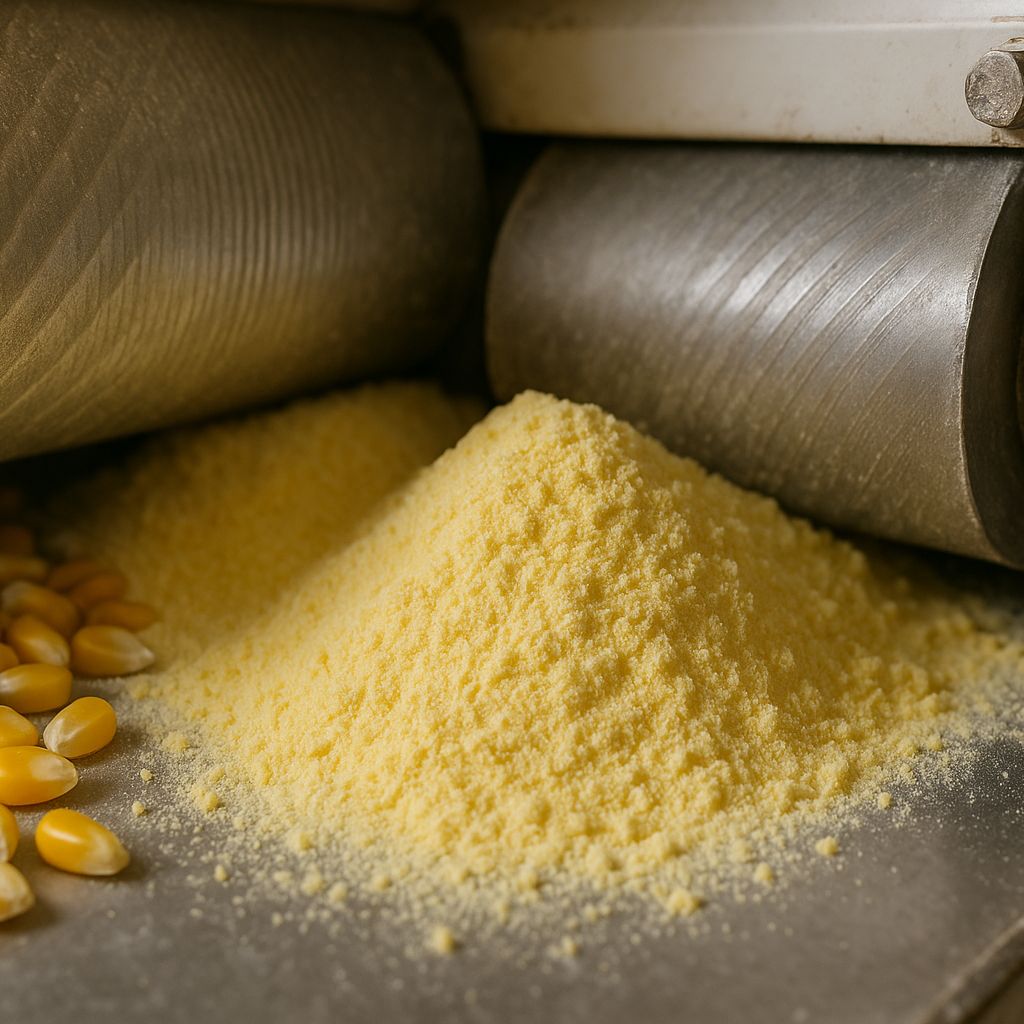Ever wondered why your flour mill isn’t giving you the consistent results you expect?
I’ve seen countless millers struggle with this exact problem. You’ve got the best wheat, your equipment looks fine, but somehow the break roll performance just isn’t meeting your expectations. Trust me, you’re not alone in this. The thing is, break roll performance in milling depends on multiple interconnected factors that most people overlook.
Today, I’ll walk you through the 10 crucial factors that directly impact how well your break rolls perform in the milling process. By the end of this article, you’ll understand exactly what’s affecting your mill’s efficiency and how to optimise each element for better results.
Understanding Break Roll Performance in Milling Operations
Before we dive into the factors, let me quickly explain what we’re talking about. Break rolls are the first stage in flour milling where wheat kernels get opened up. Break rolls are fluted and operate under a differential of about 2.5:1, with the fluting breaking open the wheat kernel such that the bran tends to stay relatively intact in large particles, while the endosperm shatters into small particles. This separation is crucial for quality flour production whether you’re processing wheat or grains like maize corn flour. Poor break roll performance means you’ll get inconsistent particle sizes, reduced extraction rates, and ultimately, lower-quality flour.
Factor 1: Wheat Moisture Content and Conditioning
This is probably the most critical factor affecting your break roll performance. Conditioning moisture, tempering time, roll gaps setting, feed rate and temperature influence the milling performance of wheat.
Here’s what happens when moisture isn’t right:
- Too dry wheat (below 14%): Creates excessive flour dust, increases power consumption, and reduces endosperm recovery
- Too wet wheat (above 17%): Causes sticky particles, clogs screens, and creates uneven grinding
The sweet spot for most wheats:
- Hard wheat varieties: 16-19% moisture content
- Soft wheat varieties: 15-17% moisture content
Tempering is done for 18-72 hours in tempering bins, and due to osmosis and different biochemical properties, bran and endosperm swell at different rates, making the bonds between them weak.
Pro tip: Always check your wheat moisture before milling.
Even a 1% variation can significantly impact your break roll efficiency.
Factor 2: Wheat Quality and Hardness
Different wheat types behave completely differently under break rolls. Hardness, class or origin and moisture are a few of the wheat quality characteristics that must be considered.
Hard wheat characteristics:
- Requires more aggressive roll settings
- Produces coarser particles initially
- Needs longer tempering time
Soft wheat characteristics:
- Breaks down more easily
- Produces finer particles quickly
- Requires gentler roll pressure
Mixed wheat blends create their own challenges. You need to adjust your break roll settings based on the predominant wheat type in your blend.
Factor 3: Roll Gap Settings and Pressure
Getting your roll gaps right is like tuning a musical instrument.
Too tight, and you’ll create excessive fines.
Too loose, and you won’t get proper kernel opening.
Typical first break settings:
- Gap: 1.0-1.2mm for hard wheat
- Gap: 0.8-1.0mm for soft wheat
Uniform performance along both ends and center of the mill will increase product uniformity and wear uniformity maximizing roll life.
Check these regularly:
- Roll gap consistency across the length
- Pressure distribution
- Roll alignment
Even small variations can create uneven particle size distribution.
Factor 4: Roll Surface Condition and Flute Design
Your roll surface condition directly impacts grinding efficiency.
Fresh, sharp flutes:
- Create clean kernel opening
- Produce consistent particle sizes
- Require less power
Worn or damaged flutes:
- Cause excessive heating
- Create irregular particles
- Increase power consumption
Key maintenance points:
- Regular flute sharpening schedules
- Proper flute angle maintenance
- Surface hardness monitoring
Don’t wait until performance drops dramatically.
Prevention is always better than repair.
Factor 5: Feed Rate and Material Flow
Overfeeding your break rolls is like trying to drink from a fire hose.
It just doesn’t work well.
Optimal feed rates depend on:
- Roll diameter and length
- Wheat type and conditioning
- Desired extraction rate
Signs of improper feed rate:
- Inconsistent particle sizes
- Increased power consumption
- Uneven roll wear
The roll surface capacity is expressed as mm per 100 kgs per 24 hours.
Monitor your feed rate consistently.
Small adjustments can make huge differences in performance.
Factor 6: Roll Speed and Differential Settings
The speed relationship between your fast and slow rolls is crucial. Break rolls operate with a differential (ratio of fast roll speed to slow roll speed) of about 2.5:1, and operating the rolls under a differential reduces energy consumption.
Why differential matters:
- Creates shearing action for kernel opening
- Reduces overall power consumption
- Improves endosperm separation
Common problems:
- Too high differential: Excessive wheat heating
- Too low differential: Poor kernel opening
- Inconsistent differential: Uneven particle sizes
Always maintain your differential within the recommended range for your specific wheat type.
Factor 7: Temperature Control During Milling
Heat is the enemy of quality milling.
Excessive temperature during break roll operation can:
- Damage wheat proteins
- Create sticky particles
- Reduce flour quality
- Increase power consumption
Temperature monitoring points:
- Wheat temperature before milling
- Roll surface temperature
- Ground material temperature
Cooling strategies:
- Proper ventilation systems
- Roll cooling (if available)
- Controlled feed rates
Keep your milling temperatures below 40°C for optimal results.
Factor 8: Roll Material and Hardness
Not all rolls are created equal. The material and hardness of your break rolls significantly impact performance.
Common roll materials:
- Chilled cast iron (traditional)
- High chrome iron (improved wear resistance)
- Special alloy compositions (premium performance)
Modern mills use advanced materials with continuous research and development, creating high performance and wear-optimized special materials that achieve better results than traditional chilled cast iron rolls.
Hardness considerations:
- Harder rolls last longer but may create more fines
- Softer rolls give gentler treatment but wear faster
- Hardness differential between rolls affects performance
Choose roll materials based on your specific wheat types and production requirements.
Factor 9: Maintenance Schedule and Roll Alignment
Consistent maintenance is non-negotiable for optimal break roll performance.
Critical maintenance tasks:
- Daily roll gap checks
- Weekly alignment verification
- Monthly bearing lubrication
- Quarterly comprehensive inspection
Signs your rolls need attention:
- Inconsistent particle sizes
- Increased noise levels
- Higher power consumption
- Uneven wear patterns
Roll alignment issues cause:
- Excessive edge wear
- Poor grinding efficiency
- Increased maintenance costs
- Reduced roll life
Don’t skip maintenance schedules.
The cost of prevention is always less than the cost of emergency repairs.
Factor 10: System Integration and Process Control
Your break rolls don’t work in isolation.
They’re part of a complete milling process system.
Integration factors:
- Upstream cleaning efficiency
- Conditioning system performance
- Downstream sieving capacity
- Overall mill balance
Process control elements:
- Consistent feed preparation
- Real-time monitoring systems
- Automated adjustments
- Quality control feedback
Mill diagram design considerations include the number of break passages, the linear inches or millimeters of roll length allocated to the break system as well as desired granulation of the end product.
System optimization requires:
- Proper capacity matching between stages
- Consistent material flow
- Real-time performance monitoring
- Regular system audits
At CMS Industries, we understand how crucial proper wheat conditioning is for optimal milling performance. Our expertise in agricultural products means we can help you source the right quality wheat that responds well to milling processes.
When you have consistent, properly conditioned raw materials, your break roll performance improves dramatically.
Optimising Your Break Roll Performance
Now that you understand these 10 factors, here’s how to put this knowledge to work:
Start with the basics:
- Establish consistent wheat conditioning protocols
- Monitor moisture content religiously
- Maintain proper roll gap settings
- Keep detailed performance records
Advanced optimisation:
- Implement real-time monitoring systems
- Develop wheat-specific milling protocols
- Create predictive maintenance schedules
- Train operators on performance indicators
Performance indicators to track:
- Extraction rates by passage
- Particle size distribution
- Power consumption per tonne
- Roll life and wear patterns
Remember, small improvements in each factor compound to create significant overall performance gains.
Troubleshooting Common Break Roll Issues
Problem: Inconsistent particle sizes
- Check roll gap uniformity
- Verify feed rate consistency
- Inspect roll surface condition
Problem: High power consumption
- Review roll differential settings
- Check for roll misalignment
- Verify wheat conditioning
Problem: Poor endosperm separation
- Adjust tempering time
- Review roll pressure settings
- Check flute sharpness
Problem: Excessive heating
- Reduce feed rate
- Improve ventilation
- Check roll differential
Most break roll performance issues stem from one or more of these 10 factors being out of optimal range.
The Future of Break Roll Technology
The milling industry continues to evolve with new technologies:
Emerging trends:
- Smart sensors for real-time monitoring
- Automated gap adjustment systems
- Advanced roll materials
- Predictive maintenance algorithms
Benefits of modern systems:
- Consistent performance
- Reduced operator intervention
- Lower maintenance costs
- Better quality control
Staying updated with these developments can give you a competitive edge in milling efficiency.
Taking Action for Better Performance
Understanding these factors is just the beginning.
The real value comes from systematic implementation and monitoring.
Your next steps:
- Audit your current break roll setup against these 10 factors
- Identify the biggest performance gaps
- Prioritise improvements based on impact and cost
- Implement changes systematically
- Monitor results and adjust accordingly
At CMS Industries, we’ve seen how proper attention to these fundamentals transforms milling operations. Our experience in agricultural products gives us unique insights into how raw material quality affects processing performance.
We’re committed to helping Indian millers achieve optimal results through better understanding of these critical factors.
Conclusion
Break roll performance in milling isn’t just about having good equipment. It’s about understanding and optimising the complex interaction between wheat quality, equipment settings, maintenance practices, and process control. These 10 factors work together to determine your overall milling success.
Focus on getting the basics right first wheat conditioning, roll maintenance, and proper settings. Then gradually implement more advanced monitoring and control systems. Remember, even small improvements in break roll performance can lead to significant gains in flour quality, extraction rates, and operational efficiency, especially when processing various grains efficiently.
Ready to optimise your milling operation?
Start by evaluating these factors in your facility and see where you can make the biggest impact on your milling process performance.
Frequently Asked Questions
Q1: What’s the ideal moisture content for wheat before break roll milling?
Hard wheat should be conditioned to 16-19% moisture, while soft wheat works best at 15-17% moisture. Proper tempering time of 18-72 hours is equally important for optimal break roll performance.
Q2: How often should break rolls be sharpened or replaced?
This depends on usage, but typically every 3-6 months for high-volume operations. Monitor particle size consistency and power consumption as indicators for when maintenance is needed.
Q3: Why does my break roll create too much flour dust?
Excessive flour dust usually indicates wheat that’s too dry, worn roll flutes, or incorrect roll gap settings. Check moisture content first, then inspect roll condition.
Q4: What’s the correct roll differential for break rolls?
Break rolls typically operate at a 2.5:1 differential (fast roll to slow roll ratio). This creates the shearing action needed for proper kernel opening while minimising power consumption.
Q5: How do I know if my break roll performance is optimal?
Monitor extraction rates, particle size distribution, power consumption per tonne, and roll wear patterns. Consistent performance across these metrics indicates optimal operation.





